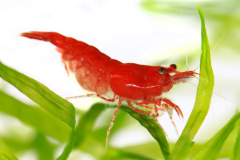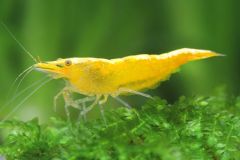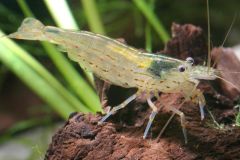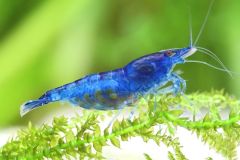Pet Shrimp: Guide for care, tank setup, feeding, and breeding pet shrimp in your aquarium Pet Shrimp Overview:
Imagine adding a touch of vibrant color and fascinating behavior to your aquarium with pet shrimp! These captivating creatures can be a delightful addition to any freshwater aquarium, as long as you provide them with the proper care, tank setup, feeding, and breeding practices. In this blog post, you’ll discover everything you need to know to ensure the health and well-being of your pet shrimp. Let’s dive into the world of pet shrimp keeping!
Table of Contents
Short Summary
- Choose the right freshwater shrimp for your aquarium, Neocaridina and Caridina!
- Keep water parameters in check to ensure a healthy environment for pet shrimp.
- Feed them nutritious food, maintain their tank regularly, and choose compatible tank mates to create a thriving community in your aquarium!
Choosing the Right Freshwater Shrimp for Your Aquarium
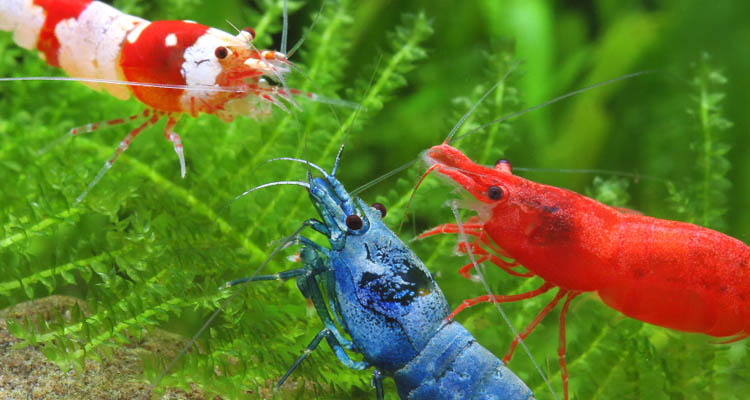
When starting your shrimp-keeping journey, it’s essential to choose the right shrimp species for your aquarium. With a plethora of freshwater shrimp species available, Neocaridina and Caridina shrimp are the most popular choices among aquarists. Each species has its own unique care requirements and color variations, making them ideal candidates for your shrimp tank. But how do you decide which one is right for you? Let’s explore these amazing shrimp species and their specific needs, so you can make an informed decision.
Neocaridina shrimp are beginner-friendly, hardy, and come in a variety of stunning colors, making them the go-to choice for many shrimp enthusiasts. On the other hand, Caridina shrimp, which include species like Crystal shrimp, Amano shrimp, Blue Bolt shrimp, and Bamboo shrimp, are more sensitive and require specific water conditions. This makes them more suitable for experienced shrimp keepers who can provide the necessary care for these delicate creatures.
Regardless of your choice, both Neocaridina and Caridina shrimp will surely add a splash of color and excitement to your aquarium.
Neocaridina Shrimp
Neocaridina shrimp, also known as dwarf freshwater shrimp, are perfect for beginners because of their adaptability and hardiness. These shrimp can thrive in various water conditions, making them a popular choice for pet shrimp enthusiasts. Some notable Neocaridina shrimp species include the Red Cherry shrimp, Blue Dream shrimp, Green Jade shrimp, and among ghost shrimp species, the common ghost shrimp.
When it comes to caring for your Neocaridina shrimp, stable water parameters and a tropical temperature range of around 65-75°F are essential. They thrive best with PH between 7.0-7.9. They also need good water hardness of at least 8-14 degrees of hardness. They love having moss and live plants in their tank, providing them with hiding spots and natural food sources.
Feeding your Neocaridina shrimp a varied diet of small, sinking fish foods, calcium-rich shrimp foods, and catappa leaves (they eat the microorganisms off the leaves) will ensure their health and happiness. Just be sure to remove any uneaten food to maintain water quality.
Caridina Shrimp
Caridina shrimp are more challenging to care for compared to their Neocaridina counterparts due to their sensitivity to water conditions. These shrimp include , Crystal shrimp, Tiger shrimp, and the striking Blue Bolt shrimp. Caridina shrimp are best suited for experienced shrimp keepers who can provide the specific water conditions they require.
To keep your Caridina shrimp healthy and happy, it’s crucial to provide them with soft water and a temperature range of around 65-75°F. A 10-gallon or larger tank is recommended, as the larger the water volume the easier to keep it stable. Caridina shrimp need an active substrate that buffers the water below 7.0 PH. In terms of water hardness they need 2-5 degrees of hardness. Caridina shrimp are known for their vibrant colors and energetic behavior, making them a rewarding addition to any aquarium.
Pet Shrimp Water Parameters
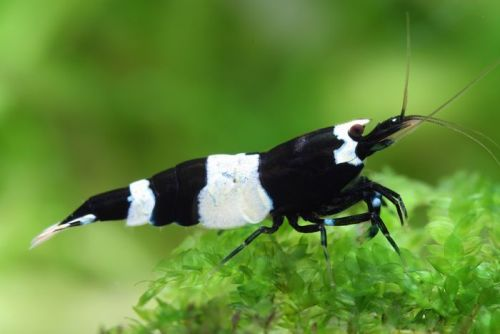
Proper water parameters are crucial for the health and well-being of your pet shrimp. Neocaridina and Caridina shrimp have different water requirements, but both species need stable and clean water conditions. Ammonia, nitrite, and nitrate levels are extremely important for all pet shrimp, including the popular Bee shrimp.
To maintain optimal water conditions, monitor your shrimp tank regularly and perform partial water changes once a week. This will help keep nitrate levels low and ensure your shrimp have clean water to thrive. Additionally, be extra cautious when adding supplements to your tank, as shrimp are highly sensitive to copper and other harmful substances.
Neocaridina Shrimp
Neocaridina shrimp are known for their adaptability, allowing them to thrive in a range of water conditions. However, stable water parameters are still essential for their health. The ideal water conditions for Neocaridina shrimp include a GH (general hardness) of 8-14, KH (carbonate hardness) of 4-7, and a pH of 7.0-7.6. They prefer soft water that is slightly acidic or neutral.
In addition to the parameters mentioned above, it’s crucial to monitor temperature, ammonia, nitrite, and nitrate levels regularly. Ensuring these levels stay within the recommended range will help your Neocaridina shrimp prosper in your aquarium.
Caridina Shrimp
Caridina shrimp have more specific water requirements compared to Neocaridina shrimp. They require soft water, with ideal parameters including a pH bleow 7.0, GH of 2-5, KH of 0-2, and a temperature range of 65-75°F.
Maintaining these specific water conditions is crucial for the health of your Caridina shrimp. Consistently monitor the water parameters in your tank and perform regular water changes to ensure your sensitive Caridina shrimp thrive in their environment.
It should be noted most shrimp keepers who keep cairdina shrimp only use RODI water with a remineralizer of saltyshrimp Gh+ type of products in order to get these ideal water parameters in combination of an active substrate.
Pet Shrimp Tank Setup
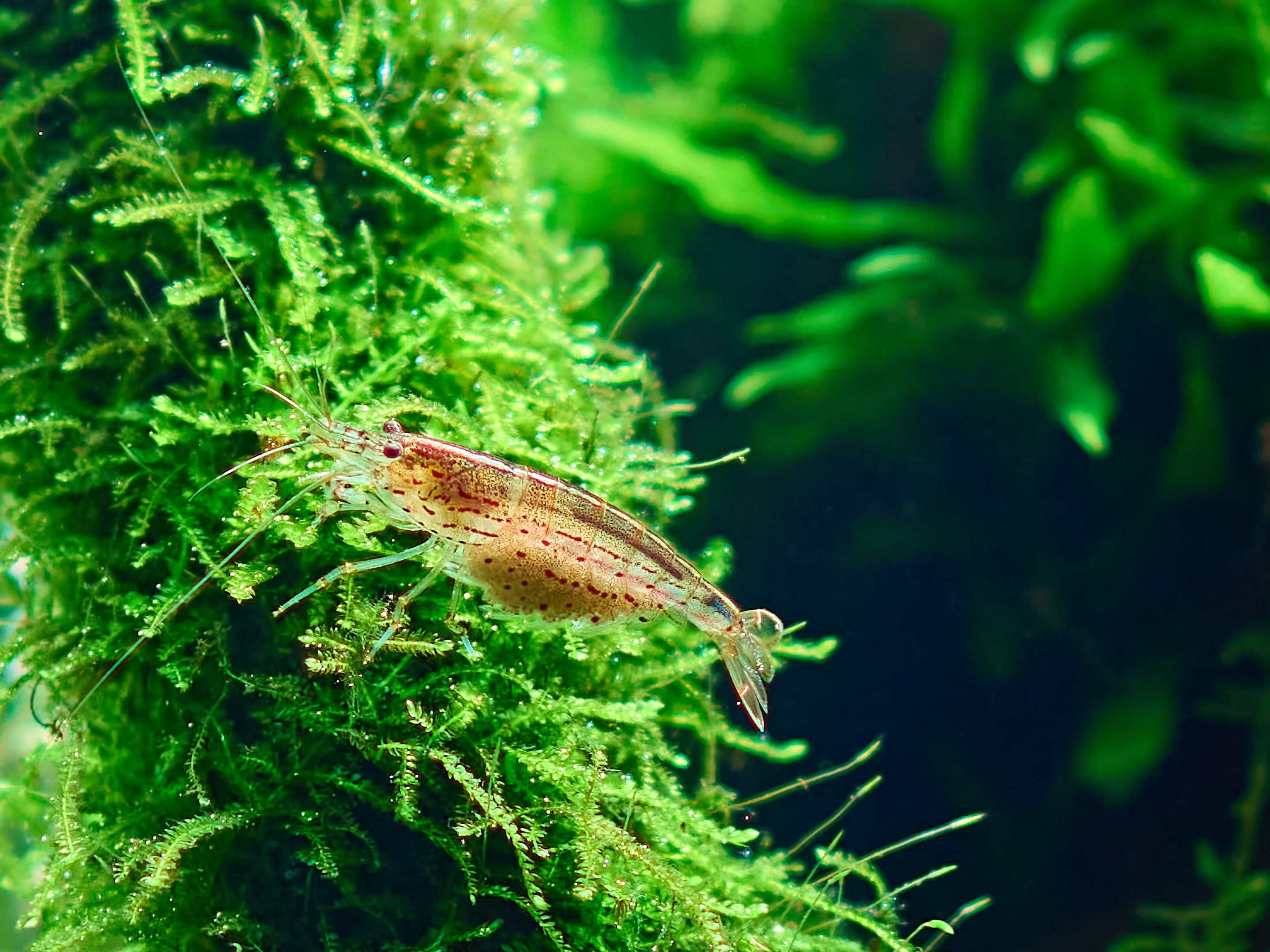
Setting up the perfect shrimp tank is essential for your pet shrimp’s well-being. A proper setup includes an appropriate tank size, filtration, substrate, and live plants to create a comfortable environment for your shrimp. A 10-gallon tank or larger is recommended for beginner shrimp keepers.
Filtration is vital in maintaining water quality in a freshwater aquarium. A simple, air-powered sponge filter is highly recommended for a freshwater shrimp tank, especially when housing freshwater aquarium shrimp. This is due to shrimp being able to be sucked up by Hang on back filters or other types. This can be prevented by covering the inlet of those filters with sponges or pantyhose. When it comes to substrate, choose between sand or gravel for an inert substrate or active aquarium soils like Tropica Aquarium soil for heavily planted tanks. Live plants are a fantastic addition to your shrimp tank, as they help remove excess nutrients, oxygenate the water, and improve water quality.
Ensure your tank is well-covered with a lid to prevent any adventurous shrimp from leaping out. Amano shrimp are known jumpers. Perform regular tank maintenance, including weekly water changes, to maintain optimal water quality for your pet shrimp. By providing a comfortable and well-maintained environment, your pet shrimp will be able to thrive and display their fascinating behaviors.
Live plants such as a basic floating plant ofduckweed or red root floater in combination with a moss like Java moss are ideal to provide natural food for your shrimp.
Maintenance for Your Pet Shrimp Tank
Regular tank maintenance is crucial to ensure high water quality for your pet shrimp. Perform weekly or bi-weekly water changes and monitor water parameters, including ammonia, nitrite, and nitrate levels. By maintaining a clean and stable environment, your pet shrimp will be able to thrive and showcase their vibrant colors and lively behaviors. In general the goal should always be to keep parameters stable rather than spot on a certain number. Stable water parameters are key to sucess.
Water changes can be done at 10-20% of tank volume, cupping water out or siphoning is fine. During tank maintenance, be cautious when using a gravel vacuum to avoid accidentally sucking up your shrimp. It is possible to prevent clogging of gravel vacuums by fitting a fine mesh or stocking over the end. This will ensure that nothing gets stuck along the way. By maintaining a clean and stable environment, your pet shrimp will be able to thrive and display their fascinating behaviors.
Feeding Your Pet Shrimp
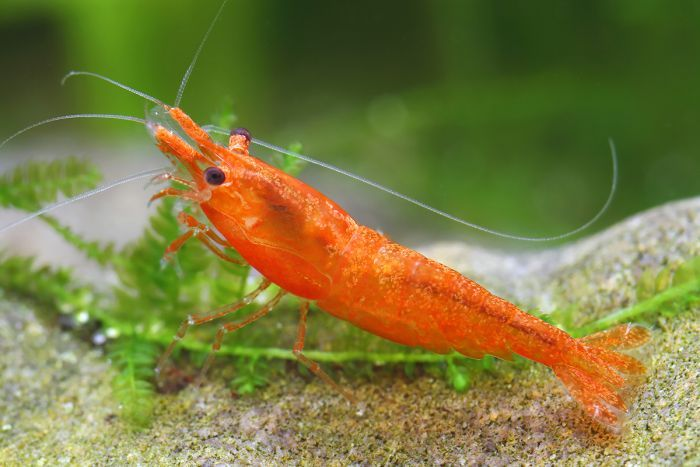
To ensure a balanced diet for your pet shrimp, provide them with a mix of flakes, micro-organisms, and calcium-rich shrimp foods. Shrimp are omnivores, so offering them a variety of foods will help keep them healthy and satisfied. Feed your pet shrimp once a day, ensuring that you don’t overfeed them, as this can lead to water quality issues. Shrimp are also opportunistic feeders, meaning they will eat anything they can which even includes dead shrimp!
It’s essential to remove any uneaten food from the tank after a few minutes to maintain water quality. By providing your pet shrimp with the proper nutrition they need, you’ll ensure their health, growth, and breeding success.
Pet Shrimp Tank Mates: Compatibility and Considerations

Choosing compatible tank mates for your pet shrimp is essential to ensure a harmonious and stress-free environment. When selecting fish or other invertebrates to share the tank with your shrimp, consider species that won’t harm or stress your shrimp. This is important to remember: any fish that has a mouth large enough to consume a shrimp poses a danger to these tiny creatures. It is prudent to be aware of this fact before adding any new fish to your aquarium.
Fish Tank Mates
When it comes to fish tank mates for your pet shrimp, small and peaceful species are the best choice. For example, cory catfish are a great option as they are non-aggressive and won’t harm your shrimp. Other suitable fish species include guppies, Endler guppies, and Emerald tetras.
It’s essential to avoid keeping large or aggressive fish with your pet shrimp, as they can pose a threat to their safety. By choosing fish tank mates that are compatible with your pet shrimp, you’ll create a harmonious environment where all inhabitants can flourish.
Please note if any fish are kept with shrimp, this will create an environment where the shrimp tend to hide more as they are natural prey animals.
Shrimp/snail Tank Mates
Shrimp and snail tank mates should be compatible and non-aggressive to ensure a peaceful environment for your pet shrimp. Freshwater snails, such as Nerite snails and Mystery snails, are popular tankmates for pet shrimp due to their peaceful nature and compatibility.
When selecting snail species as tank mates, consider their size and growth rate to prevent overcrowding or competition for food resources. By choosing compatible shrimp and snail tank mates, you’ll create a thriving and harmonious community in your aquarium that all inhabitants can enjoy.
Breeding Freshwater Pet Shrimp
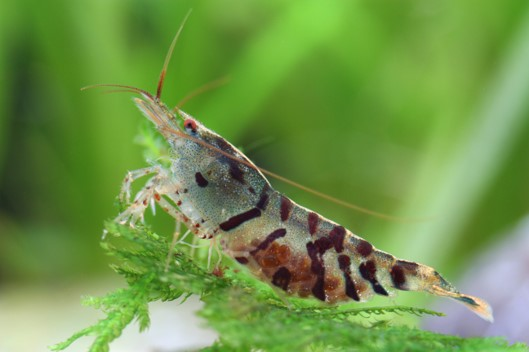
Breeding freshwater pet shrimp can be an exciting and rewarding aspect of shrimp keeping. With proper water quality and care, breeding can be relatively easy. However, it’s essential to know how to differentiate between male and female shrimp to ensure successful breeding.
Good water quality and the right parameters are the keys to successful shrimp breeding. If these are in place, you will be giving your pet shrimp the optimum environment for a healthy life. By creating a comfortable and well-maintained environment for your shrimp, they will be more likely to reproduce and fill your tank with tiny baby shrimp.
Knowing the parameters needed for Neocaridina or Caridina as stated above is the place to start to put your shrimp into the best environment to breed. Adding live plants like moss and feeding a slightly higher protein based diet with help get the breeding started. If optimal conditions are met shrimp are know to breed like "rabbits". Overpopulation of the tank generally doesn't become a problem so no need to worry.
How to tell Male from Female Pet Shrimp
Identifying male and female pet shrimp can be challenging, but it’s essential for successful breeding. Observing the size, coloration, and body shape of your shrimp can help determine their sex. Typically, female shrimp are larger and have more vibrant colors compared to males.
Males and females can also be distinguished by their body shape. Females have a wider, more rounded abdomen, while males have a narrower, more triangular abdomen. By being able to differentiate between male and female shrimp, you’ll increase your chances of successful breeding and enjoy watching your shrimp population grow.
Here is a helpful article we posted on how to determine males from females
Overview
In conclusion, pet shrimp are fascinating and colorful additions to your aquarium. Proper care, tank setup, feeding, and breeding practices are essential for their health and well-being. By following the guidelines and tips provided in this blog post, you’ll be well on your way to creating a thriving and happy environment for your pet shrimp.
With the right knowledge and dedication, you can ensure that your pet shrimp will live a long and healthy life.
Frequently Asked Questions
Shrimps make great pets! Not only are they visually striking and hardy, they can also be kept in a smaller tank, making them perfect for offices, classrooms, or even living rooms.If you’re looking for an aquatic pet, shrimp should definitely be on your list of considerations!
Pet shrimp usually have lifespans of two years. They develop quickly, maturing in a matter of weeks. It’s incredible how much these little creatures can fit into such a short lifetime!
Despite being easier to keep than fish, pet shrimp require specific water parameters and can be very sensitive to changes. As such, they can be considered high maintenance creatures!
For aquarists just starting out, the Neocaridina Davidi (aka dwarf cherry shrimp) is an excellent, hardy choice for a pet shrimp!



 Shrimp
Shrimp Fish
Fish Crab &
Crab & Plants
Plants Foods
Foods Snails
Snails